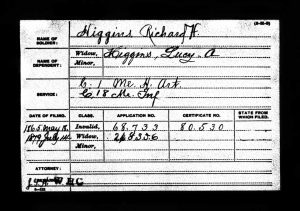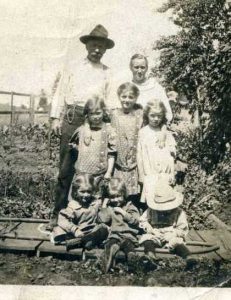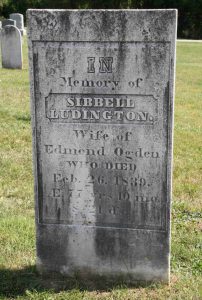 I wrote two years ago about the incredible value of Civil War pensions, but a recent example reminded me that occasionally just getting a valuable pension may be challenging as well. Whenever I realize a Civil War pension exists, whether for a book project or an article, I almost always request it, on the strong likelihood that it will provide further genealogical information, as well as substantial biographical data on the veteran’s life, his widow, and sometimes other family members. Continue reading Bunching pensions
I wrote two years ago about the incredible value of Civil War pensions, but a recent example reminded me that occasionally just getting a valuable pension may be challenging as well. Whenever I realize a Civil War pension exists, whether for a book project or an article, I almost always request it, on the strong likelihood that it will provide further genealogical information, as well as substantial biographical data on the veteran’s life, his widow, and sometimes other family members. Continue reading Bunching pensions
Category Archives: Lineage Societies
It’s good to get divorced

As those who have applied to hereditary societies may already know, several groups have a policy of requiring every birth, marriage, and death certificate for the most recent three generations of the lineage, with like information for their spouses. While this may not be difficult for everyone, some may not not know where all of these events occurred, especially for the generation of their grandparents. Legal access to these records varies from state to state, and not every state has readily available indices to such records. The following is an interesting example of utilizing records when your ancestors eloped.
In this case, my friend’s wife was applying to the Mayflower Society and trying to locate the marriage of her father’s parents (both of whom are deceased, as is her father). The announcement at left appeared in The New York Times on 12 June 1942 announcing a marriage that had occurred on 23 March 1942. No indication of the place of marriage is given, and no formal announcement of the couple’s engagement had appeared before this notice. The bride was a resident of New York City, and no record of their marriage was found there, nor back in the groom’s native Ohio. Where they got married appeared to be a mystery, and no one alive in the family knew either. Continue reading It’s good to get divorced
A tale of two Ogles

There is a remote area in the study of family history. Some will call it a myth, or say it has no proper place in the field of study. It hides from anyone who would study it like a registrar, and rarely cloaks itself in any vital records. I’ve taken to calling it existential genealogy, and while hardly essential, I believe it is something all of us who study or experience family history encounter from time to time.[1]
As a young boy there was no one more revered in my family than my great-grandmother “Mrs. Ogle.” You may have heard me mention her before – with deference being given to her feelings concerning my grandmother’s adoption.[2] Continue reading A tale of two Ogles
Legacy
 I just spent a nice afternoon with Tom, a fellow Alden descendant and historian, talking about the Alden legacy. He is gathering information on what he’s calling his “Aldens-engaging-with-Aldenness” project that may become a book.
I just spent a nice afternoon with Tom, a fellow Alden descendant and historian, talking about the Alden legacy. He is gathering information on what he’s calling his “Aldens-engaging-with-Aldenness” project that may become a book.
He wanted to know how I was first introduced to the Aldens (my grandmother discovered our line when I was about three and had my picture taken sitting next to Priscilla’s gravestone), how I got involved with the Alden Kindred (they needed a genealogist and I needed the cachet for my professional resume), and such things as my opinions on hereditary societies and attitude towards our Pilgrim ancestors. Continue reading Legacy
Birth marks

We family historians can never get enough of a good thing, right? So in the fall of 2012 when my son and his fiancée tied the knot I was thrilled for two very different reasons: a) my new daughter in-law was going to be an awesome addition to the family, and b) with it she was bringing an entirely new family history for exploring – a welcome relief after staring at my own brick walls for too long.
Before long, I was in the thick of researching her family tree, especially those lines that would lead (where else but?) to New England. Soon enough I could see a possible Mayflower line in her grandmother’s Martell family. There seemed to be a clear path to Mayflower passenger Henry Samson. And while I wasn’t intent on signing up my new daughter-in-law for the GSMD, I knew I had to be able to prove this for my own benefit – and for any future grandchildren (wink). Continue reading Birth marks
Bye-bye-bye
 Following up on correcting the charts in my Seeing double blog post, the chart showing my ancestor Anna (Salisbury) Slade was a recent disappointment and involved removing some ancestors from my charts. The chart identified Anna’s parents as Daniel Salisbury and Anna Hale, and had Anna as the child of Rev. Moses Hale (Harvard 1699) and Mary Moody of Newbury, with several early Newbury ancestors including Henry and Jane (Dummer) Sewall, who were the parents of Judge Samuel Sewall (1652–1730), known for his involvement in the Salem witch trials. Continue reading Bye-bye-bye
Following up on correcting the charts in my Seeing double blog post, the chart showing my ancestor Anna (Salisbury) Slade was a recent disappointment and involved removing some ancestors from my charts. The chart identified Anna’s parents as Daniel Salisbury and Anna Hale, and had Anna as the child of Rev. Moses Hale (Harvard 1699) and Mary Moody of Newbury, with several early Newbury ancestors including Henry and Jane (Dummer) Sewall, who were the parents of Judge Samuel Sewall (1652–1730), known for his involvement in the Salem witch trials. Continue reading Bye-bye-bye
In praise of Sybil Ludington

Paul Revere’s famous ride is often the jumping off point for thinking about the Revolutionary War. But there is a lesser known patriot – a woman, too – who helped win the war and changed the course of history.
Her name was Sybil Ludington, and she was born 5 April 1761 in Connecticut as the eldest child of Henry and Abigail Ludington. On the rainy night of 25 April 1777, as British troops were advancing to attack Danbury, Connecticut, Sybil, only 16 years old at the time, took off on her famous 40 mile horseback ride to alert approximately 400 militiamen under the control of her father, Colonel Henry Ludington. She was chosen for the task because the original messenger, who had ridden to notify her father of the advancing British troops, was too tired from his first trip and could not proceed. Continue reading In praise of Sybil Ludington
Patriots
 My Daughters of the American Revolution lineage is filed through Bernice Crane of Berkley, Massachusetts. I have other ancestors that I could have chosen, but I chose Bernice for a special reason – he is definitely my most interesting patriot ancestor.
My Daughters of the American Revolution lineage is filed through Bernice Crane of Berkley, Massachusetts. I have other ancestors that I could have chosen, but I chose Bernice for a special reason – he is definitely my most interesting patriot ancestor.
Bernice and his wife Joanna (Axtell) Crane were Tory sympathizers at the beginning of the Revolution. One family story says that Bernice Crane, a sea captain, “carried word to the Torries in New York until the Whigs ran his small craft ashore, when he became a patriot.” This decision was likely also influenced by the tar and feathering of his next door neighbor and cousin, Lemuel Crane. Continue reading Patriots
Irregular border marriages in Scotland

Not long ago, I was searching for a record of an 1830s marriage between two prominent Scottish families. I was certain I would have an easy time locating this particular record, having identified the parish and county in which the couple were married, so I began my search. Yet while I searched several sources, including Given Name Index to Marriages in Old Parochial Registers to 1855,[1] and Scotland Marriages, 1561-1910, I found no record of the marriage. I attempted the search again using every variation of the surname I could think of, but struck out. I then turned to published genealogies regarding the two families, but found no mention of this particular couple’s marriage. Continue reading Irregular border marriages in Scotland
The Jamestowne Chancel Burials

The announcement Tuesday of the (probable) identification of the remains of four men buried under the chancel of the first parish church at Jamestowne, Virginia – first discovered in 2010 and unearthed in 2013 – has now made the front page of The Wall Street Journal and appeared in other leading news outlets. While not the first Englishmen to die in the nascent American colony, they were nearly so, probably interred in Virginia soil in 1608 and 1610, more than a decade before the Mayflower arrived on American shores; these men were certainly among the colony’s founders. Continue reading The Jamestowne Chancel Burials